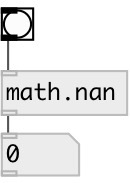PureData CEAMMC web documentation
PureData CEAMMC library web documentation
Distribution download
index :: math
math.nan
Not a Number, unrepresentable value
available since version: 0.1
information
In computing, NaN, standing for not a number, is a numeric data type value representing an undefined or unrepresentable value, especially in floating-point calculations. Systematic use of NaNs was introduced by the IEEE 754 floating-point standard in 1985, along with the representation of other non-finite quantities like infinities. When an operation results in a quiet NaN, there is no indication that anything is unusual until the program checks the result and sees a NaN. That is, computation continues without any signal from the floating point unit (FPU) or library if floating-point is implemented in software. A signalling NaN will produce a signal, usually in the form of exception from the FPU. Whether the exception is thrown depends on the state of the FPU. Note: in Pd float point exceptions are disabled.
properties:
-
@quiet Get/set alias to @type quiet
type: alias -
@signal Get/set alias to @type signal
type: alias -
@type Get/set type of outputed NaN: quiet or signal
type: symbol
enum: quiet, signal
default: quiet
inlets:
- outputs value
type: control
outlets:
- output value
type: control
keywords:
See also: [math.nan~] [math.inf]
Authors: Serge Poltavsky
License: GPL3 or later
